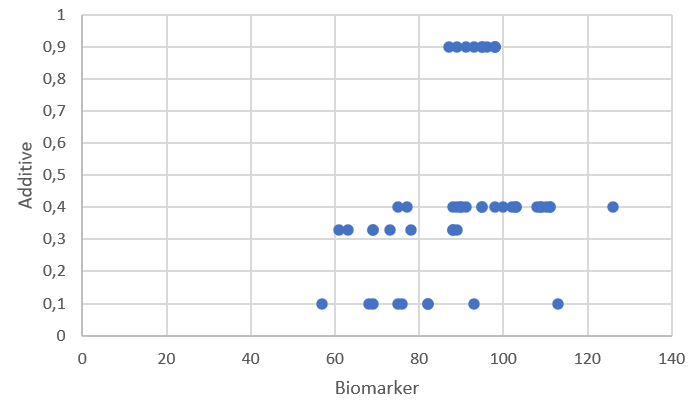Assuming from the visuals of it that there does not seem to be some simple rule (linear relationsship, exponential relationship) between the four concentrations and assuming that there are only few discrete points on the Additive scale to find such a relationship, I'd resort to looking at the Additive concentrations as nominal.
In that case, a simple one-way ANOVA with the concentrations (or the farm) as the grouping variable to compare the means and find proof of differences of means seems in order.
Alternatively, if we try to find a smooth function, a GAM could do that.
Your data looks a bit like this:
expl <- data.frame(additive = rep(c(.9, .4, .33, .1), c(8, 17, 7, 8)),
biomarker = c(85:92,
75, 77, 89:93, 95, 98, 100, 103, 104, 108:112,
60, 62, 64, 72, 78, 89, 90,
57, 68, 69, 75, 76, 83, 94, 115))
ggplot(expl, aes(x = additive, y = biomarker)) +
geom_point(aes(x = additive, y = biomarker), size = 2, color = "blue") +
scale_x_continuous(breaks = c(.9, .4, .33, .1)) +
geom_smooth(method = "lm") +
theme_minimal()

The straight line of the linear regression is obviously a poor fit. A Generalized Additive Model (GAM) could be used:
> gam(biomarker ~ s(additive, k = 3), data = expl) |> summary()
Family: gaussian
Link function: identity
Formula:
biomarker ~ s(additive, k = 3)
Parametric coefficients:
Estimate Std. Error t value Pr(>|t|)
(Intercept) 87.925 2.271 38.72 <2e-16 ***
---
Signif. codes: 0 ‘***’ 0.001 ‘**’ 0.01 ‘*’ 0.05 ‘.’ 0.1 ‘ ’ 1
Approximate significance of smooth terms:
edf Ref.df F p-value
s(additive) 1.763 1.944 1.974 0.117
R-sq.(adj) = 0.0875 Deviance explained = 12.9%
GCV = 221.55 Scale est. = 206.24 n = 40
However, coming from observations at only 4 discrete points, would you believe that the following cubic spline represents biological truth?

Notably, the elaborated GAM does not yield a significant result, the above mentioned ANOVA does:
> oneway.test(biomarker ~ as.factor(additive), data = expl)
One-way analysis of means (not assuming equal variances)
data: biomarker and as.factor(additive)
F = 6.9074, num df = 3.000, denom df = 14.287, p-value = 0.004209
You will have to decide what method delivers the answers that you need and which answer makes biological sense. Given, that the four groups are not only differing in Additive but also in farm specific details, the ANOVA appears more sensible to me.



